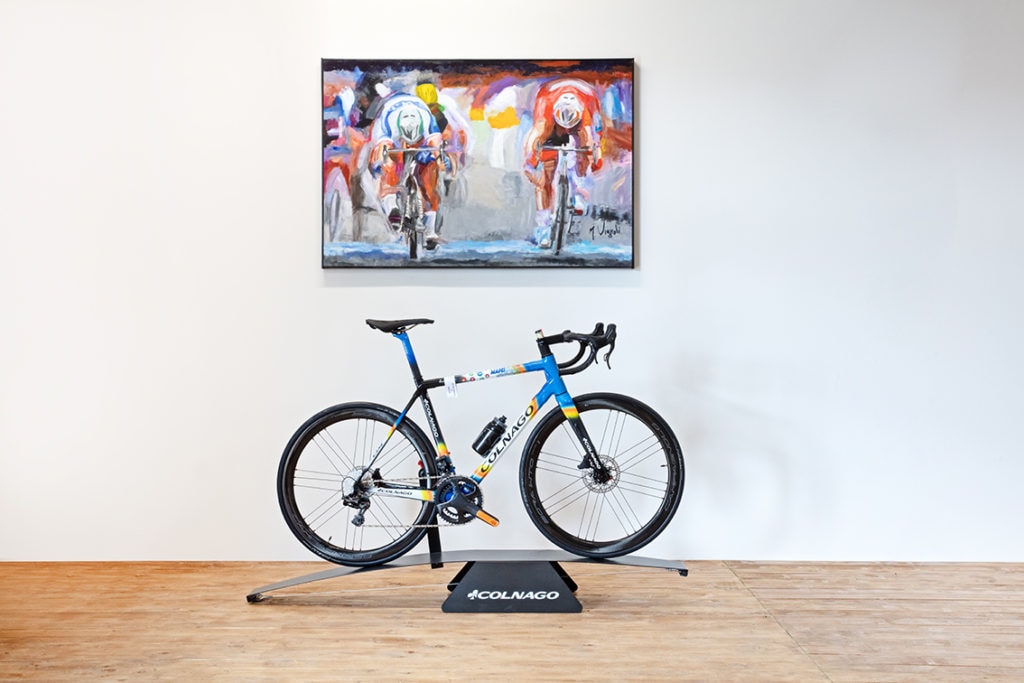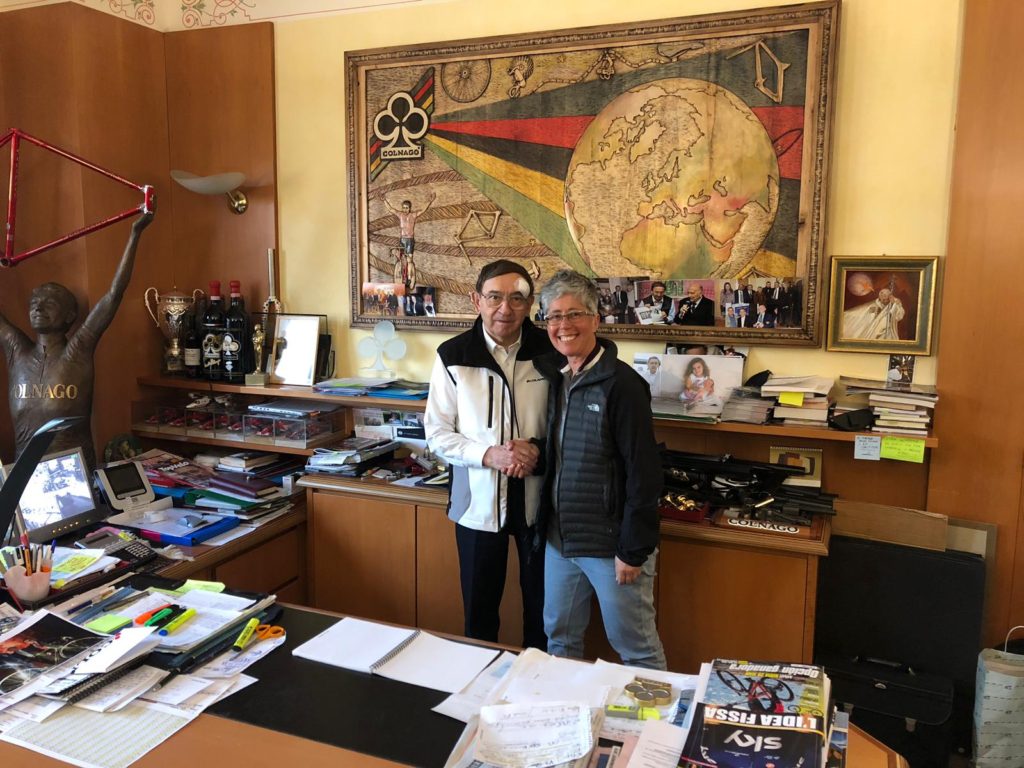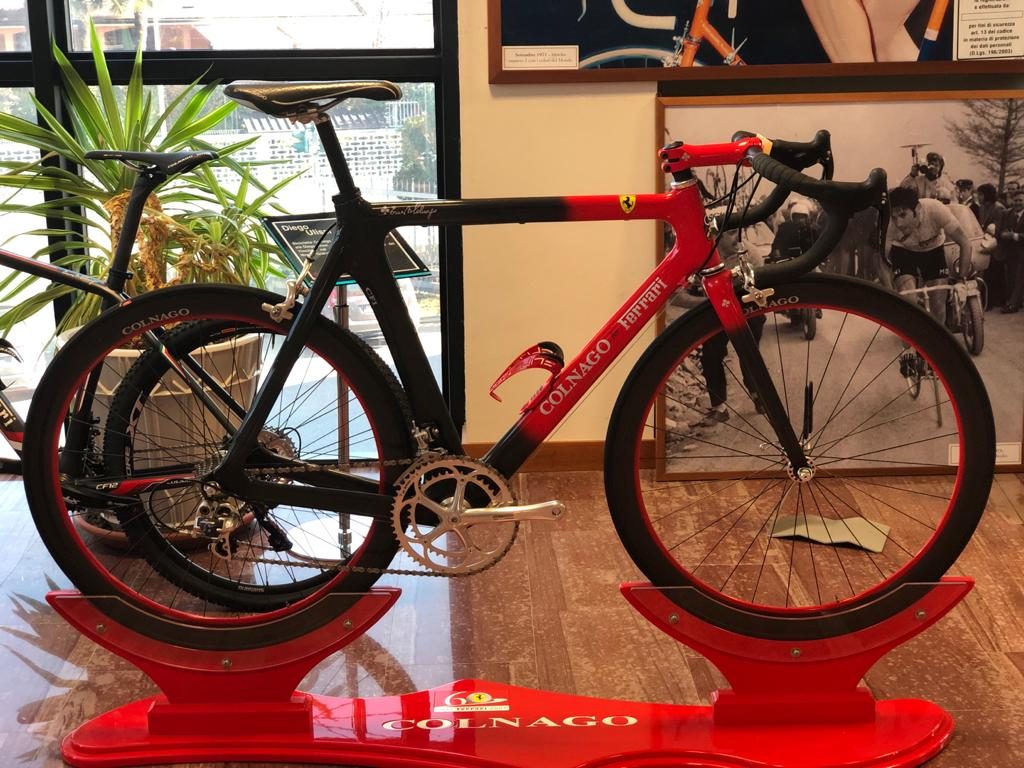16 Jul Ernesto Colnago faces an Industry: What you Need to Know Before Wrapping Your Legs Around this Italian Cycling Icon.
Colnago strikes a familiar chord. Considered by most the pinnacle of Italian road bike design, this unique brand is also at the heart of cycling innovation. Regarded as one of the best cycling bikes in the world, these machines are sleek, study and simply beautiful to look at. Yet when most bicycles are music to your ears, Colnago sings a chorus of divine cherubs.

The bike industry’s modern players tend to forget that it was Colnago – and particularly owner Ernesto Colnago – who changed the market, bringing waves of innovation to the cycling business. He consistently chased the perfect bike frame through science, less interested in earnings. And while Ernesto still maintains his headquarters in Cambiago – just outside Milan – he is well aware of the sensation he created among cycling enthusiasts.
He produces high-end racing bikes and Tuscany Bicycle brings those bikes to the streets of Tuscany. And now you can get on one too, especially if you’re thinking of riding the L’Eroica historic bicycle race.
But what is the secret behind a Colnago C64? It’s a long history involving a number of different characters. But the most important story has something to do with a mulberry tree, a welder and a fake ID.
The Birth of a Standard
You could say Ernesto Colnago was always part monello. He was certainly eager to get his hands working on bicycle parts early in his life. In 1945, at the young age of 13, Ernesto falsified working papers to be hired as a full-time tradesman. The Gloria di Milano factory hires him as a machinist. By the time Ernesto becomes a young welder, AMF Milano had over 20 years of design, research and welding experience, and Ernesto took all of that to heart.
After ten years of apprenticeship and learning, Ernesto opened a small shop in the village of Cambiago, just northeast of Milan, next to the future motor-city of Monza.
However, Ernesto had no bench to work on. His father cut down the family mulberry tree and fashioned from its trunk a fine workbench for his son to build bicycles upon. And from this bench a legend was born.
Lending a Hand
Through his work and study of bicycle engineering, the young builder was able to understand bicycles as few contemporaries could. One day, as Ernesto was riding from his shop, he encountered Fiorenzo Magni: considered the “third man” within the rivalry of Fausto Coppi and Gino Bartali.
Fiorenzo complained to Ernesto of chronic leg-pains. Ernesto, looking at the champion’s bottom bracket, noticed the crank arms were mounted improperly. He fixed the bike, becoming Fiorenzo’s second mechanic during the victor’s win of the giro d’Italia in 1955. Fiorenzo’s win solidified Ernesto Colnago’s reputation as a quality mechanic for the rest of history.
From Mechanic to Bike Builder
From 1962 to 1966, Ernesto was with legendary cyclist Gianni Motta and the Molteni team. Gianni brought home a Giro d’Italia win and a Tour de France 1st place finish with Colnago as his primary mechanic.

Colnago’s shop grew with his popularity and he assisted in many professional bike races. As he added mechanics to his team, he began testing new techniques in bike frame building. He began cold-bending frame tubes in order to preserve their elasticity. Increased flexibility meant a smoother ride for the cyclist. By fixing two pieces of wood to his mulberry workbench, he created a system to bend and manipulate the steel without compromising its integrity.
Eddy Merckx and Colnago
In 1967, Belgian phenomenon Eddy “The Canibal” Merckx is in the market for good wheels prior to the Milano-San Remo of that same year. Colnago answers the call, building bomb-proof wheels by hand. In a four-man finish, Merckx won the race.
In Merckx’s quest for the time-trial record of 1972, he looks to Ernesto Colnago for a solution. The young frame builder constructs a bicycle similar to Merckx’s track bike for one of the most incredible bike race finishes of last century and the title of time-trial champion.
By this point, Colnago isn’t simply a mechanic. He has become a man who understands the body, the needs of a cyclist and the all-important union between man and machine. He has also become a man sought-after by important Italian industrialists.
The Carbon-Fiber question
Imagine the master of bicycle frame building meeting the master of auto racing: Enzo Ferrari.

That’s what happened in 1995. When everyone was asking “Will it break?” Colnago pursued science with Ferrari, introducing a carbon-fiber bicycle frame for the 1995 Paris-Roubaix. The C40 was considered the revelation – and the risk – of the nineties. However the risk paid out over five times in the following editions of this classic competition. Colnago’s ingenuity brought his cyclists to the Hell of the North’s podium year after year.
Safety in Technology
Colnago works its carbon-fiber like it were steel. In cold-tube metal bending, the point of least resistance is in the joint. Carbon fiber’s maximum tolerance between the junction mustn’t be lower than 0.15mm. Ernest has studied these numbers and is focused on safety. This maximum tolerance allows for perfect bonding, allowing the carbon fiber tubes to react naturally to torsional flex without compromising the bond. After the structural integrity is confirmed, then each bicycle gets its own 3D design. This “virtual” bicycle respects the esthetic and style worthy of a Colnago. 100% pure Italian design.
A Special Bond
But this bonding agent is something out-of-this-world. The substance used is a aerospace bi-component, maintaining its adherence under a torque of well over a ton. For over three years Colnago has been executing torsion and torque tests in partnership with the Polytechnic University of Milan to see how far they can push the bonds.
These frames see a lot of abuse, but nothing is more punishing than the “impact test.” During this exam, a weight of 24.5 kg (industry standard is 22.5) is dropped from varying heights (from 350mm to well over a meter) along the length of the frame. The Colnago C64 wins every part of this stress test, with a frame that never fails even from heights of well over a meter.
Attention to Detail, Dedication to Safety
The C60 series bicycles are hand made and tested by the Colnago factory in Milan. Over decades Ernesto’s attention to quality craftsmanship has brought victories to Merckx, Fondriest, Rominger, Popovych, Bettini and many others. As the first manufacturer of carbon bikes in the nineties, Ernesto was the first to exhibit disk brakes at the 2012 Taipei Bike Show. Again, he threw an industry on its head and everyone had to follow.
Straight forks, lightweight frames, thin carbon walls and rigid structures; there is nothing stopping Ernesto and his team of scientists. The allure of Italian design, the science of structure and the passion for a sport all blend harmoniously in a Colnago.
Ready to see yourself on a Colnago? When in Tuscany send us a message or email, and let’s get riding!




No Comments